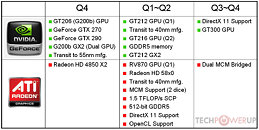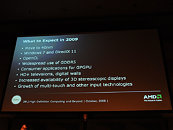
AMD Radeon RV840 Graphics Card Caught on Camera
Yesterday, AMD unveiled its surprise for this year's Computex, with a demonstration of a DirectX 11 3D scene. Behind the scenes though, was what AMD claimed to be the "world's first true DirectX 11 graphics processor". The hardware itself however, wasn't publicly displayed, although a memento of AMD's partnership with TSMC, a wafer of 40 nm DirectX 11 GPUs, was made public. VR-Zone however, sneaked into the backdrops and pictured the machine that ran the demo (which ironically, was built into a case with a side-window).
The graphics card, a portion of which, is hidden behind the "wing" of the AMD Dragon logo graphic, is seen to be about 8.5 inches long, spans across two slots, and has a seemingly sporty cooler with the ATI-red shroud. It draws power from a single 6-pin PCI-E connector. The photographers note that this could be the RV840-based desktop accelerator, which forms the performance-mainstream product for the company's upcoming DirectX 11-compliant GPU lineup codenamed "Evergreen". The first product from this series is expected to be released in September, weeks ahead of the launch of Microsoft Windows 7.
The graphics card, a portion of which, is hidden behind the "wing" of the AMD Dragon logo graphic, is seen to be about 8.5 inches long, spans across two slots, and has a seemingly sporty cooler with the ATI-red shroud. It draws power from a single 6-pin PCI-E connector. The photographers note that this could be the RV840-based desktop accelerator, which forms the performance-mainstream product for the company's upcoming DirectX 11-compliant GPU lineup codenamed "Evergreen". The first product from this series is expected to be released in September, weeks ahead of the launch of Microsoft Windows 7.









